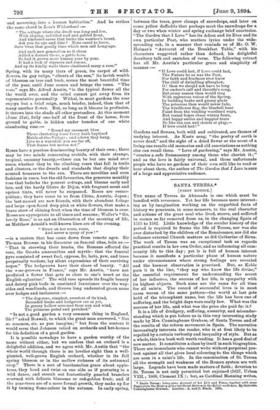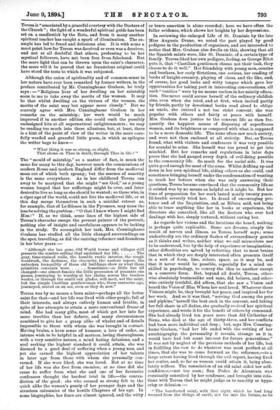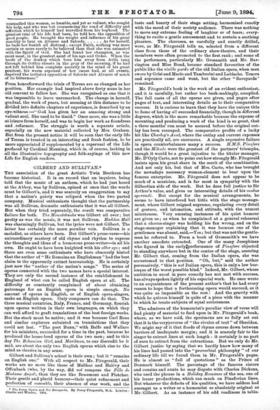THE name of Teresa de Ahumada is one which must
be handled with reverence. Yet her life becomes more interest-
ing as by imagination working on the ungarbled facts of history we penetrate, in some measure, to the real character and actions of the great soul who lived, strove, and suffered in scenes so far removed from us, in the changing Spain of 1515 to 1582. Little knowledge of the secular history of the period is required to frame the life of Teresa, nor was she ever disturbed by the children of the Renaissance, nor did she influence external Church matters as did Catherine of Siena. The work of Teresa was an exceptional task as regards practical results in her own Order, and as influencing all com- munity life to this day ; yet it is fall of human interest because it manifests a particular phase of human nature under circumstances where strong feelings are revealed and the keenest observation is practised. But, as ICeble puts it in the line, "they say who knew the life divine," the essential requirement for understanding the secret of her influence, the success of her life, is sympathy with its highest objects. Such aims are the same for all time for all saints. The record of successful lives is in most cases woven of the same pattern—the world at last gets hold of the triumphant name, but the life has been one of suffering, and the bright days were really few. What was the success of her life, and what was the price she paid for it ?
It is a life of drudgery, suffering, austerity, and misunder- standing which is put before us in this very interesting study made by Mrs. Cuiminghame Graham, of Santa Teresa and of the results of the reform movement in Spain. The narrative increasingly interests the reader, who is at first likely to be repelled by a certain verbosity and inequality of style. But as a whole, this is a book well worth reading. It has a good deal of new matter. It constitutes a class by itself in such biographies. There are iconoclasts who cannot write without perpetual pro- test against all that gives local colouring to the things which are seen in a saint's life. In the canonisation of St. Teresa all the strength and weakness of the Roman system are writ large. Legends have been made matters of faith ; devotion to St. Teresa is not only permitted but enjoined (1627, Urban VIII.; 1668, Clement IX ) ; but, as Cardinal Manning writes,
• Santa Teresa : being some Account of her Lire and Times, together with some Pages from the History of the last Great Refer nt in the Religi Orders. Ay Gabriela, Ounninghame Graham. London : A. and C. Black. 1894.
Teresa is "associated by a graceful courtesy with the Doctors of the Church"; the light of a wonderful spiritual guide has been set on a candlestick by the Rota, and from it many another spiritual teacher has caught a spark of illumination. The ex- ample has led to fraud and delusions also. It is with some a moot point how far Teresa was deceived or even was a deceiver, and not at all doubtful that others, professing to be her mystical followers, have not been free from falsehood. But the more light that can be thrown upon the saint's character, the more will it be proved that no fraudulent original could have stood the tests to which it was subjected.
Although the union of spirituality and of common-sense in her nature have ever been remarked by former writers, in the preface contributed by Mr. Cunninghame Graham, he truly says : — "Religious lives of her dwelling on her saintship seem to me to take away the merits of the woman. It may be that whilst dwelling on the virtues of the woman, the merits of the saint may but appear more closely." But we scarcely agree with Mrs. Cunninghame Graham in her remarks on the saintship ; her work would be much improved if in another edition she could omit the possibly undesigned hits at all supernatural enlightenments ; we may be reading too much into these allusions, but, at least, there is a hint of the point of view of the writer in the more care- fully worded and graceful little poem, in which as epilogue the writer begs to know-
" What thing it was so strong, so slight, That shone on Thee in death, through Thee in life ? "
The "mould of saintship," as a matter of fact, is much the same for many to this day, however much the communions of modern Rome and modern England differ from the medimval mass out of which both sprang; but the essence of sanctity is the same everywhere. As in her childhood Teresa ran away to be martyred that she might "see God," as a young woman longed that her sufferings might be over, and later desired to live so long as she should be wanted ; so those who, in a riper age of the world, could not live the medimval life, or at this day merge themselves in such a suicidal retreat as, for example, that of Le Silence in the Pyrenees, may none the less be solving the problem : "0 that I knew where I might find Him !" If, as we think, some lines of the highest side of Teresa's character escape the present painter of the portrait, nothing else of insight and carefulness appears to be lacking in the study. To accomplish her task, Mrs. Canninghame Graham has studied all the little changed surroundings on the spot, travelling, as did the untiring reformer and foundress in her later years :—
" Although she has gone, Old World towns and villages still
preserve the sombre setting that enshrined her life The gray, time-stained walls, the humble rustic interior, the rough woodwork, the darkness, the obscurity, the austere repose, the unbroken tranquility of those old buildings show us what these 'primitive convents were Sometimes—so little has all changed—one almost fancies the little procession of peasants one passes, journeying to worship at her shrine across the treeless wastes, or through the sunlit oak glades, will meet, not the saint, but the simple Castilian gentlewoman who, three centuries ago, journeyed, seated on an ass, even as they do now."
Teresa was by no means a born saint—perhaps all the better saint for that—and her life was lived with other people, full of their interests, and always entirely human and lovable, in spite of her attempts to attain a more conventional frame of mind. She had many gifts, most of which got her into far more troubles than her defects, and many circumstances combined to give her a grasp alike of wholes and of details impossible to those with whom she was brought in contact.
Having brains, a keen sense of humour, a love of order, an intense wish to be helpful in all matters, loving thoroughness, with a very sensitive nature, a mind hating delusions, and a soul seeking the highest standard it could attain, she was doomed to a good deal of suffering when a young nun, and yet she earned the highest appreciation of her talents in later age from those with whom she personally con- versed. If she were liked, she was loved. But at no time of her life was she free from enemies; at no time did she cease to suffer from what she and one of her favourite confessors thought the hardest trial in life,—the contra- diction of the good : she who seemed so strong felt to the quick alike the women's gossip of her younger days and the atrocious calumnies of the hostile Chapters of her age. In some biographies, her fears are almost ignored, and the witty or brave assertion is alone recorded; here we have often the fuller evidence, which shows her heights by her depressions.
In reviewing the enlarged Life of St. Dominic by the late Miss Augusta Drane, we noted the part played by good pedigree in the production of organisers, and are interested to- notice that Mrs. Graham also dwells on this, showing that all the Spanish saints were, like St. Dominic, of a certain type of family. Teresa liked her own pedigree, feeling, as George Eliot puts it, that "Castilian gentlemen choose not their teak, they choose to do it well." Her friendship with young men, cousins and brothers, her early flirtations, one serious, her reading of books of knight-errantry, playing of chess, and the like, and', of course, her good looks and witty tongue which gave her opportunities for taking part in interesting conversations, all such" vanities" were by no means useless in her saintly educa- tion. She never could accuse herself of the ordinary childish sins, even when she tried, and at first, when incited partly by friends, partly by devotional books read aloud to oblige an uncle, she entered a not too strict convent, she wag popular with others and fairly at peace with herself. Mrs. Graham does justice to the convent life as then fre- quently the happiest means of disposing of superfluous women, and its brightness as compared with what is supposed to be a more domestic life. The nuns often saw much society, and were not then enclosed at all strictly. But, as Teresa found, what with visitors and confessors it was very possible for scandal to arise. She herself was too proud to get into mischief. But her remarks and regulations in later days prove that she had gauged every depth of evil-doing possible to the community life. So much for the social side. It was quite good enough for most of the nuns. Whilst drifting up and down in her own spiritual life, aiding others as she could, and sometimes bringing herself under the condemnation of wanting to teach her betters when she was only answering their questions, Teresa became convinced that the community life as it existed was by no means as helpful as it might be. But her time of preparation for her work lasted nearly twenty years. Ill-health severely tried her. In dread of encouraging pre- tence and of the Inquisition, and, as Ribera said, not being able to trace anything like her in books or experience, the directors she consulted, like all the doctors who ever had dealings with her, simply tortured, without caring her.
As regards her visions and the locutions she heard, nothing is perhaps quite explicable. Some are dreams, simply the result of nerves and illness, as Teresa herself says; some undoubtedly are the ordinary flashes of extraordinary genius as it thinks and writes, neither what we call miraculous nor to be understood, but by the help of experience or imagination; other difficulties are solved by reflecting that to most brains that in which they are deeply interested often presents itself in a sort of form, line, colour, space, as it may be, and that it never would be possible, especially for a mind un- skilled in psychology, to convey the idea to another except in a concrete form. But, beyond all doubt, Teresa, other- wise absolutely businesslike and sane, did believe, and other- wise entirely truthful, did affirm, that she saw a. Vision and heard the Voice of Him Whom her soul loved. Whatever these Visions might be, they brought her peace, and inspired her for her work. And so it was that, "serving God among the pots and pipkins," herself the best cook in the convent, and taking her full share in all duties, she gradually evolved her spiritual experience, and wrote it for the benefit of others by command. She had already lived ten years more than did Catherine of Siena, who died at the age of thirty-three, and her conflicts had been more individual and deep ; but, says Mrs Cunning- hame Graham, "had her life ended with the writing of her autobiography, the personality it reveals, strange as it is, would have had but scant interest for future generations." It was not by neglect of the previous methods of her life, but in fulfilling the vow to do whatever was most perfect at all times, that she was to come forward as the reformer,—to large extent having lived through the evil report, having fixed her centre, and, so far as woman could attain it, being abso- lately selfless. The consolation of an old saint aided her self- confidence,—not too soon; San Pedro de Alcantara was eventually consulted by her confessor, and brought into rela- tions with Teresa that he might judge as to sanctity or hypo- crisy or delusion :— "The barefooted saint, with that sight which he had long weaned from the things of earth, saw far into the future, as he eMtnaellecl this woman, so humble, and yet so valiant, who sought his help, and who was but commencing the road of difficulty and affliction which he himself had travelled from his boyhood. The greatest trial of his life had been, he told her, the opposition of good ,people. He brought the weight and influence of hie great sanctity to bear on Alvarez and Sake& As for herself, he bade' her ,banish all distrust; except Faith, nothing was more oertain or more surely to be believed than that she was animated with the Spirit of God. She had found her champion, as was most 'meet, in the greatest saint of his age and Order. When the hoofs of the donkey which bore him away from Avila rang through its Gothic streets in the gray of the morning, if he had not left behind him complete security in the mind of his great penitent, his warm espousal of her cause had, at all events, deprived the irritated opposition of Salcedo and Alvarez of much of its bitterness."
From henceforward the trials of Teresa are as changed as her position. , Her example had inspired above forty nuns in her old convent to follow her. She was recognised as one that it was impossible to leave unremarked. The change in herself, gradual, the work of years, but seeming at this distance to be divided into definite chapters of experience, is described by an 'eye-witness :-,-" God has given her an amazing strong and valiant Boa She used to be timid." Once more, she was a little at leisnre from herself, and was to begin her work as foundress
and reformer. . The struggle is worth a separate article, -especially an the new material collected by Mrs. Graham. But from the present notice it will be seen that the early life of Tereaa is treated in an interesting and fresh fashion, to be more appreciated if supplemented by a reperusal of the Life prefaced by Cardinal Manning, which is, of course, lacking in all the illustrative topography and folk-sayings of this new Life for English readers.








































 Previous page
Previous page